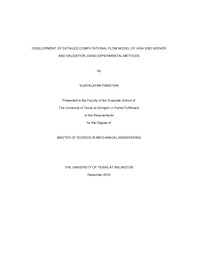
ATTENTION: The works hosted here are being migrated to a new repository that will consolidate resources, improve discoverability, and better show UTA's research impact on the global community. We will update authors as the migration progresses. Please see MavMatrix for more information.
Show simple item record
| dc.contributor.author | Pandiyan, Vijayalayan | en_US |
| dc.date.accessioned | 2013-03-20T19:12:32Z | |
| dc.date.available | 2013-03-20T19:12:32Z | |
| dc.date.issued | 2013-03-20 | |
| dc.date.submitted | January 2012 | en_US |
| dc.identifier.other | DISS-11944 | en_US |
| dc.identifier.uri | http://hdl.handle.net/10106/11611 | |
| dc.description.abstract | The continued development of the microprocessor has led to significant increase in high frequency interconnects and power dissipation. High power devices are pushing the limits of air cooling in data center environments. Data center power consumption continues to grow at a rapid pace. In light of this increasing trend in power consumption, computer systems researchers, application designers, power and cooling engineers, and governmental bodies have all launched research efforts to improve data center energy efficiency [1]. Rack servers tend to be the main perpetrators of wasting energy and represent the largest portion of the IT energy load in a typical data center. Servers take up most of the space and drive the entire operation. The majority of servers run at or below 20% utilization most of the time, yet still draw full power during the process [2]. Energy efficiency may be achieved by improving efficiency at server level. Optimization of server requires experiment with various combinations, orientations of components to help improve the performance envelope. Experimental analyses of such trials are both expensive and time consuming process. This gap is bridged by extensive use of CFD software which gives us the versatility and precision in virtually simulating a test setup. The first part of the thesis will discuss the design and flow analysis of IT servers using commercially available CFD software. The CFD modeling and analysis will include the study of pressure drop and volumetric flow through the server. The servers pull in cold air through the server inlet and push the hot air through the opposite side. The detailed modeling would help us experiment with various combinations, orientations of components to obtain a highly efficient server and also to develop a simplified or compact model of the same to analyze room and rack level study.The second part will discuss the experimental methods used to validate CFD model. The study performed in collaboration with an industrial partner and as initiation to develop simplified part library for further study. | en_US |
| dc.description.sponsorship | Agonafer, Dereje | en_US |
| dc.language.iso | en | en_US |
| dc.publisher | Mechanical Engineering | en_US |
| dc.title | Development Of Detailed Computational Flow Model Of High End Server And Validation Using Experimental Methods | en_US |
| dc.type | M.S. | en_US |
| dc.contributor.committeeChair | Agonafer, Dereje | en_US |
| dc.degree.department | Mechanical Engineering | en_US |
| dc.degree.discipline | Mechanical Engineering | en_US |
| dc.degree.grantor | University of Texas at Arlington | en_US |
| dc.degree.level | masters | en_US |
| dc.degree.name | M.S. | en_US |
Files in this item
- Name:
- Pandiyan_uta_2502M_11944.pdf
- Size:
- 1.512Mb
- Format:
- PDF
This item appears in the following Collection(s)
Show simple item record


